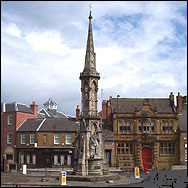 Aynhoe Park
Aynhoe Park Banbury Cross
Banbury Cross Banbury Museum
Banbury Museum Bloxham Village Museum
Bloxham Village Museum Broughton Castle
Broughton Castle Bygones Museum
Bygones Museum Hook Norton Brewery Tours and Visitors Centre
Hook Norton Brewery Tours and Visitors Centre Sulgrave Manor
Sulgrave Manor Swalcliffe Barn
Swalcliffe Barn Upton House and Garden
Upton House and Garden Waterfowl Sanctuary and Childrens Farm
Waterfowl Sanctuary and Childrens Farm
The town of Banbury in Oxfordshire dates back much further than the nursery rhyme dedicated to it.
Until a few years ago the first signs of habitation in the area went back to a Roman villa at Wykham Park from the period around 250AD. However in 2002, during excavations for the building of an office development alongside Hennef Way, the remains of an Iron Age settlement dating back to 200BC were unearthed. The site contained almost 150 items, including pottery and grinding stones, and indications of buildings from the period. The foundation holes and markings show that the buildings were circular, and it is thought that the occupants would have comprised a large family unit with their lives based on agriculture.
However, it was the Saxons in the latter half of the 5th century who first developed Banbury by building to the west of the River Cherwell. On the opposite bank they built Grimsbury, later incorporated into Banbury.
Banbury stands at the junction of two ancient roads: Salt Way, still used as a bridle path to the west and south of the town, led from Droitwich, Worcestershire to London and the south east of England, its primary use being the transportation of salt; and Banbury Lane, which began near Northampton and fairly closely followed the modern 22-mile-long road before running through Banbury's High Street and on towards the Fosse Way at Stow-on-the-Wold.
In the year 913AD a band of Danes, who had settled in Northampton, travelled along Banbury Lane and ravaged north Oxfordshire. The Danes were known to be great traders who established market towns. The outcome of their attacks is likely to have benefitted Banbury by aiding the development of the town centre. This is reflected in Banbury's Market Place, its triangular shape being typical of the Danes.
Alexander, Bishop of Lincoln, built Banbury Castle in the year 1135AD. The castle stood on the north side of the Market Place, the site now occupied largely by the Castle Quay shopping precinct. Over the centuries the castle was extended and rebuilt. The English Civil War, however, saw the end of Banbury Castle, a Royalist stronghold. It survived a siege during the winter of 1644-45 surprisingly well, considering the walls were not particularly thick or deeply founded. Earth banks gave it some protection, and the moat and a canal basin thwarted underground entry. The castle was repaired and refortified but more serious damage was sustained the following winter. The second siege began on January 23rd 1646 and lasted until April 27th when surrender on generous terms was negotiated.
Following a petition to the House of Commons in 1648 the castle was largely, but not completely, demolished and the reclaimed materials were used to repair other buildings damaged during the fighting. A painting from the end of the 18th century shows two towers rising above houses to the north of Market Place but these days nothing can be seen of the castle.
The nursery rhyme, a favourite with children throughout the English-speaking world, was first seen in print in the year 1784, although it was known in its current form in at least 1760. The "Fyne" lady is generally thought to be a member of the Fiennes family, ancestors of Lord Saye and Sele who owns nearby Broughton Castle.
During the period of the Reformation Banbury had three crosses. The High Cross, otherwise known as the Market Cross, was situated in Cornhill, just off the Market Place. This was a focal point use
No Comments Yet - Why not be the first to leave a comment
Every effort is made to make sure that all the information is correct but we strongly recommend that you call Banbury Cross before you set off on your day out to confirm opening times and admission prices.
Please also note that the position on Google maps for Banbury Cross is a rough estimate using their postcode in the database and might be slightly out.
It may also be worth clicking the web link for Banbury Cross to see if there are any special events coming up or currently on.